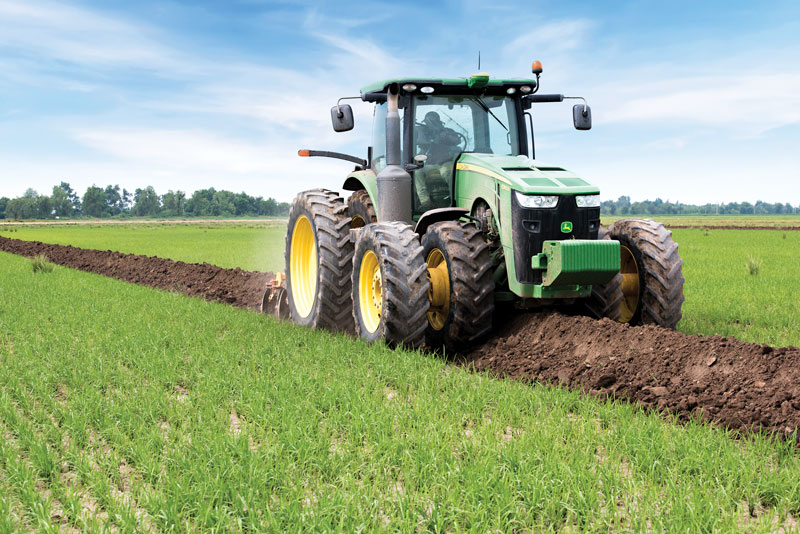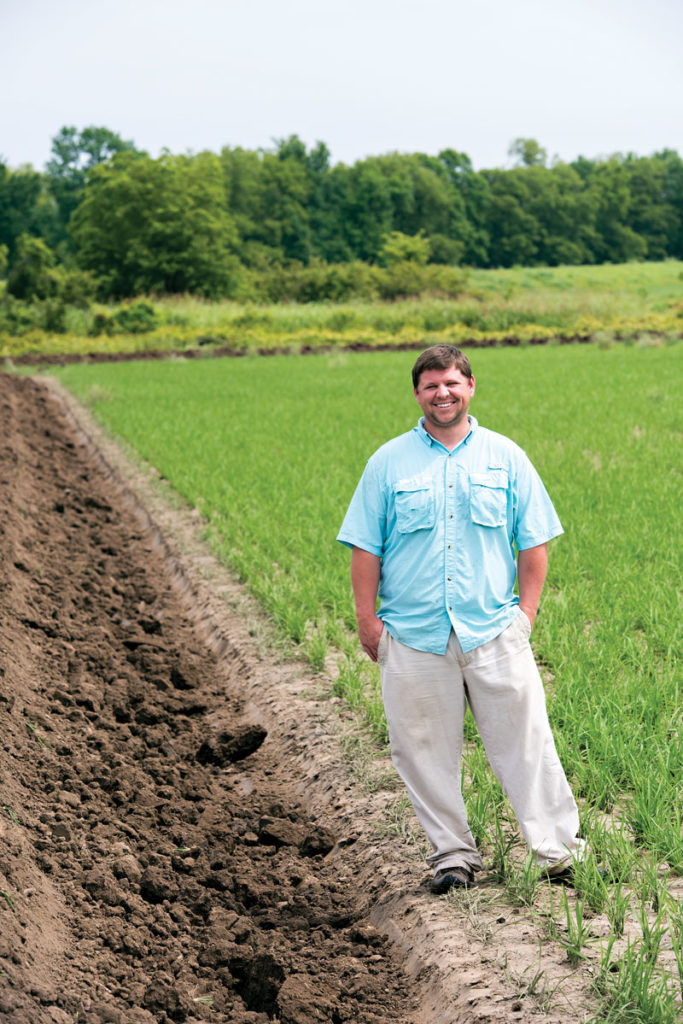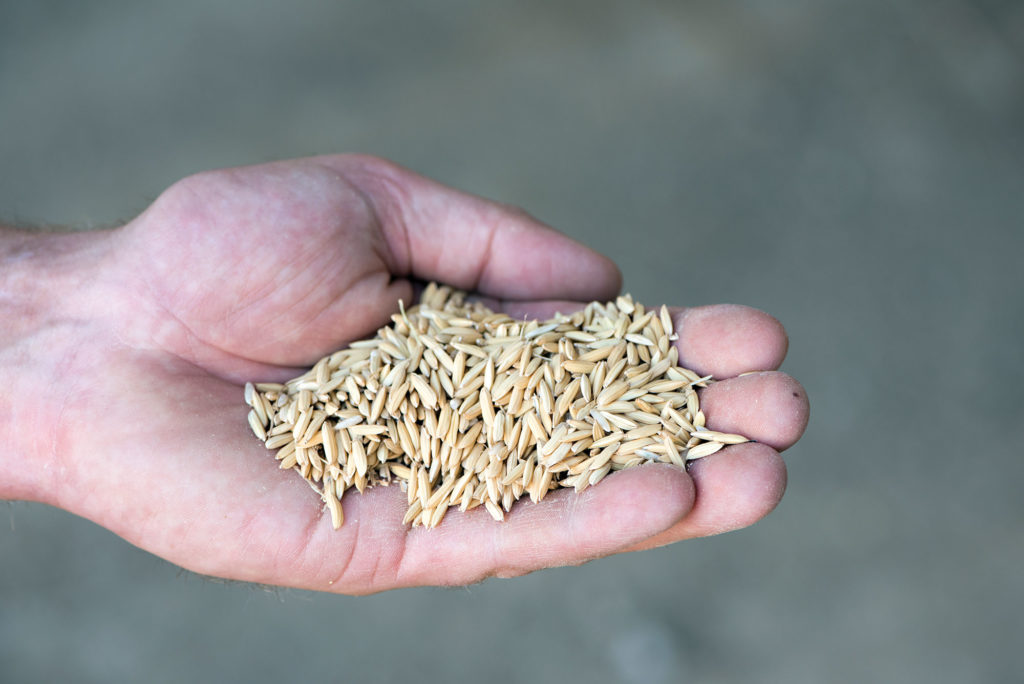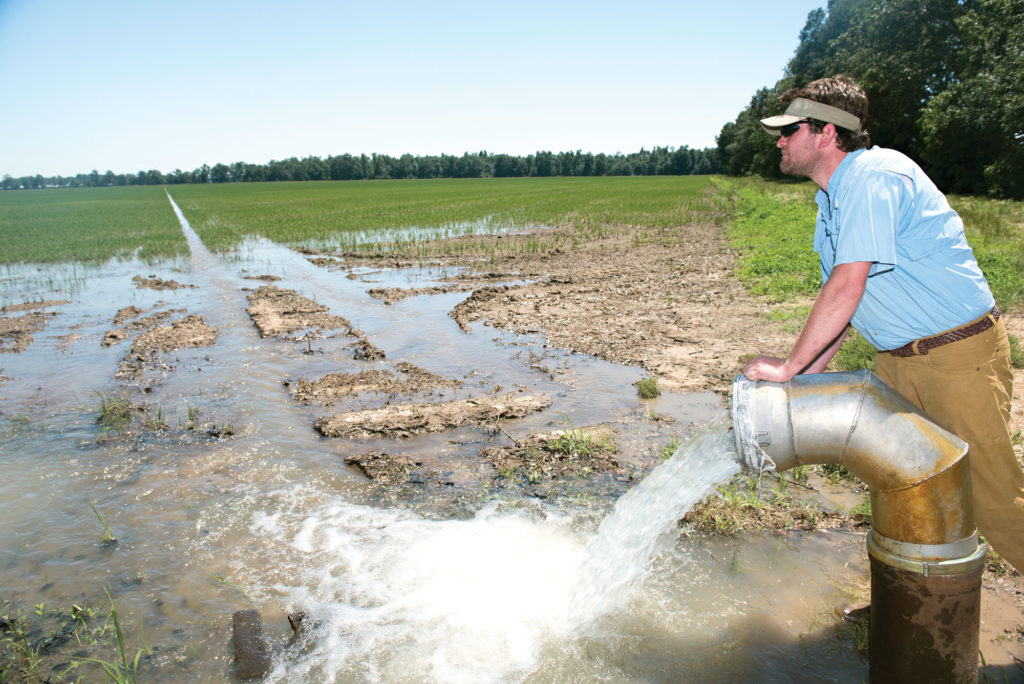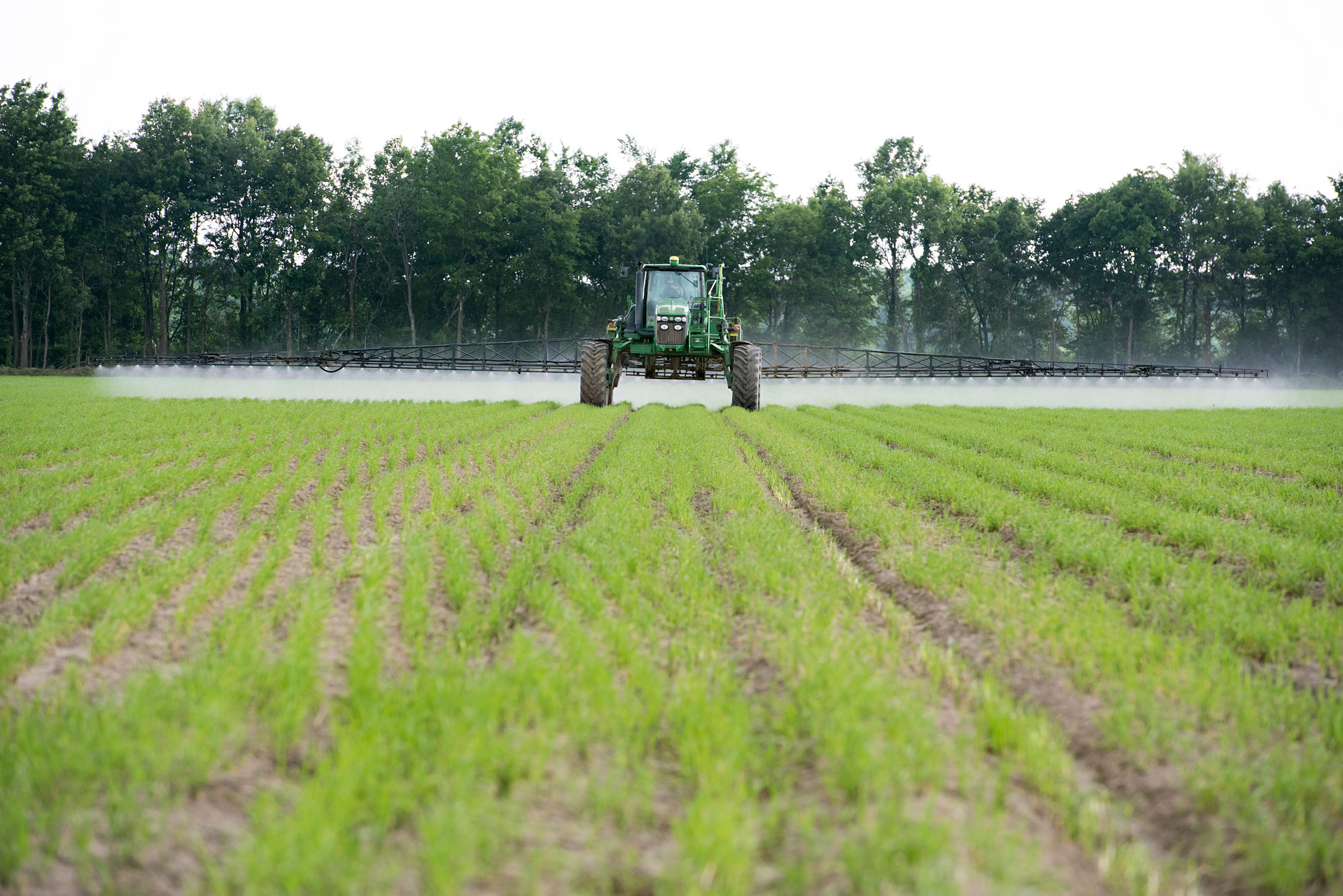
Raising Rice
July 10, 2017
Written By Jason Jenkins
The only thing tougher than rice is the farmer who grows it.
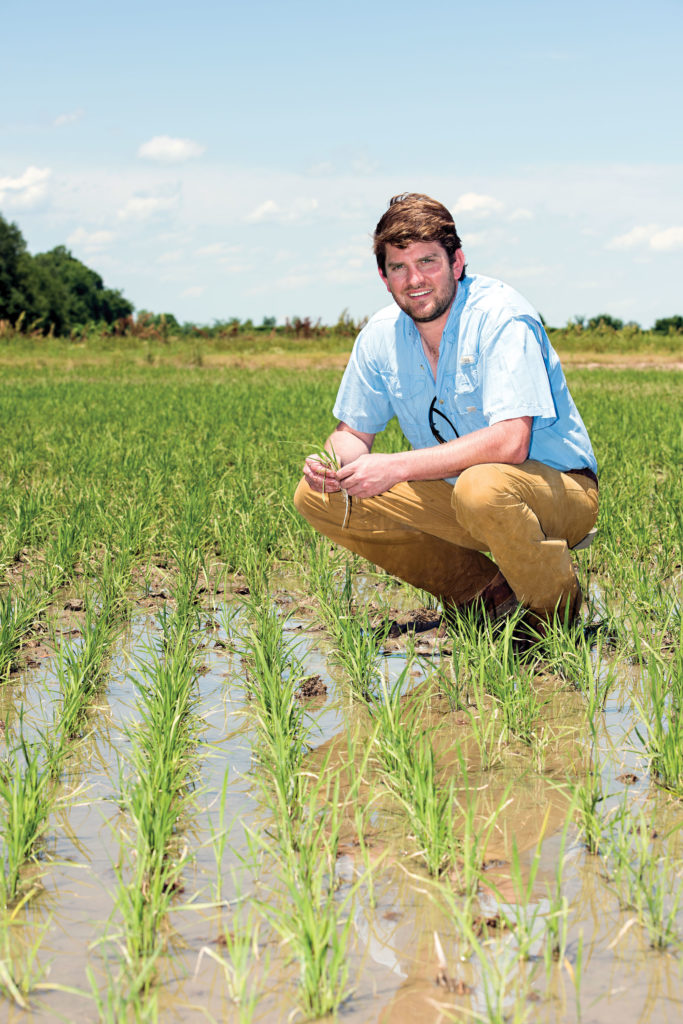
What would be the worst conditions for other crops makes the best environment for rice production. Rice thrives in heavy clay soils that retain water—the type of fields most growers try to avoid.
“An old farmer once told me that rice likes the worst ground you’ve got, and that’s what I try to do,” says Clayton Miller, who grows rice, corn, soybeans and wheat on 4,500 acres in Caraway, Ark.
Even this spring’s excessive rain couldn’t drown his early rice crop, Miller adds. Some of his fields were covered with floodwaters for up to 20 days, and yet the resilient plants survived.
“Rice may be the most expensive crop we’ve ever planted, but it’s the safest,” he says. “It’ll come out from being under water and be fine. It’s amazing how tough it is.”
Tenacious, yes, but also labor- and capital-intensive, considering the cost of irrigation, heavy fertilization and aggressive weed control. Growing rice is not for the faint of heart, says Eric Rinehart, a third-generation farmer whose family has raised this crop in the Missouri Bootheel since the 1970s. The 29-year-old is now on his 12th crop of long-grain rice and says there’s “never a year the same.”
“With rice, you don’t just plant, spray, fertilize and leave it,” he says. “Nothing about it is easy. We grow it on our roughest farms. It’s hard on equipment. Fertilizing is inefficient. It’s the most difficult crop to take care of in the bins. A rice farmer is used to dealing with a lot of things.”
Despite those challenges, rice remains an important part of the crop mix for both Miller and Rinehart, although both farmers dramatically cut their acreage this year, mainly due to economics, not weather. Miller, also 29, who has only been growing rice for the past three years, cut his acreage by more than half in 2017, from 1,300 acres to 600 acres. On his Dudley, Mo., farm, Rinehart planted just 1,600 acres, down from 3,000 acres a year ago.
Those decisions were made long before losses and delays due to spring flooding, the young farmers say. Rice prices have been steadily on the decline over the past few years while world stocks have been rising. In April, the U.S. Department of Agriculture reported a long-grain monthly average cash price of $9.39 per hundredweight, the lowest since USDA first reported monthly cash prices by class in August 2008.
By contrast, prices have been climbing for soybeans, and many farmers opted to plant this less input-intensive crop.
“Last year was a textbook year for weather and a huge bumper rice crop,” says Rinehart. “I just can’t see it adding up to that this year. If I’m not going to make any money on rice, I’d rather have less money in a bean crop.”
He’s not alone. Soybean acreage is expected to be up in both Arkansas and Missouri, according to USDA’s March 31 Prospective Plantings report, which also shows U.S. rice acreage to be down 17 percent from 2016. Specifically, long-grain rice—the type mainly grown in the Missouri Bootheel and Arkansas Grand Prairie—is projected to be down 22 percent at 1.9 million acres.
Feeding the world
The primary staple for more than half of the global population, rice is produced worldwide, with about 90 percent grown in Asia. At 18 billion pounds per year, U.S. rice accounts for only 2 percent of global production. Nearly 85 percent of the rice eaten in America is grown domestically.
“Rice is 100 percent a world market,” Rinehart says. “What happens in America really doesn’t affect the price. We could have our worst crop ever and the price of rice could still go down because the global market is what sets it all.”
With roughly 1.2 million acres each year, Arkansas leads the way among six rice-producing states in U.S. The grain is the state’s second-highest-value commodity and its top agricultural export, contributing an estimated $1.3 billion to the Arkansas economy.
Missouri ranks fourth among states for rice production. The Bootheel region is home to the industry, which produces mainly long-grain rice. Rice averages around 150,000 acres each year, contributing more than $150 million to the Show-Me State’s economy. The other U.S. rice-producing states are California, Louisiana, Mississippi and Texas.
In all these regions, water is the common denominator. Rice needs access to readily available irrigation sources. Typically, the crop is grown in precision-graded fields designed to be flooded during most of the growing season. This improves rice’s ability to compete against weeds for nutrients and sunlight and reduces the need for herbicides.
On his northeast Arkansas farm, Miller uses the traditional practice of growing rice in fields sectioned into “paddies” by earthen levees, which produce a controlled flood environment. If water were allowed to flow freely across a field without levees, parts of the field would receive no water while other parts would receive too much water, he explains.
“We put our levees 200 feet apart in a field with 0.10 percent grade,” Miller explains. “Our water will be a little more than 2.5 inches deep on the bottom end by the time you get water on the top end of the paddy. We do that for ease of getting it all flooded. It cuts it down into manageable, floodable sections.”
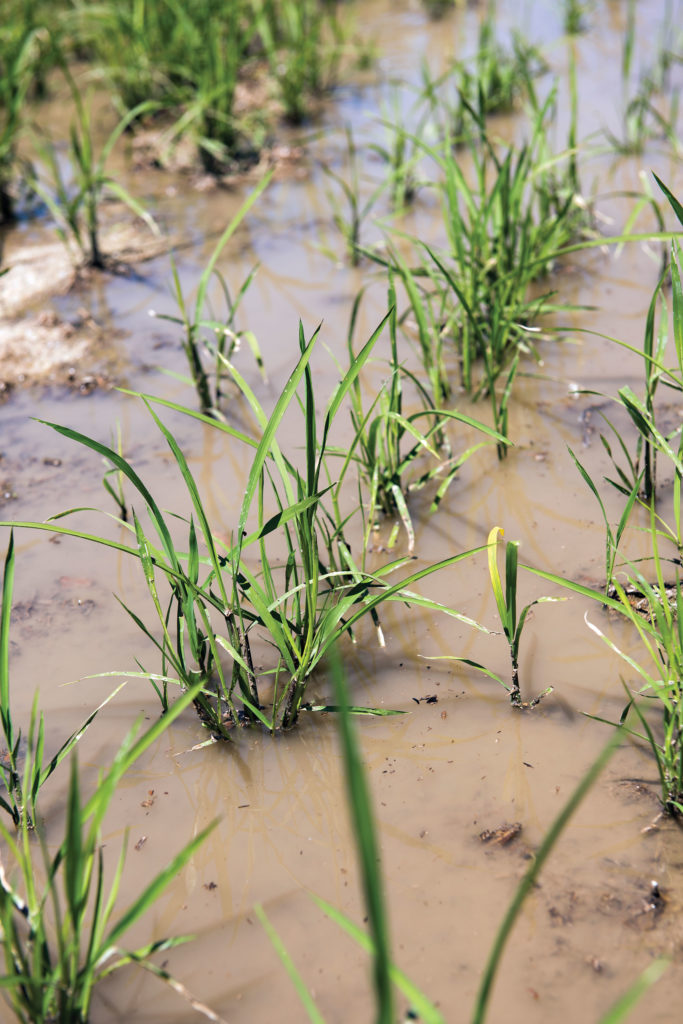
Rinehart, on the other hand, grows rice on “zero-grade” fields, which refers to land that’s been leveled to the point of no slope, like a tabletop. In this system, water is drained by a series of ditches across the field. Zero-grade fields also are typically relegated to rice alone, which means continuous rice has been standard practice in Rinehart’s 3,500-acre operation. Adding more soybeans this year has shifted that pattern.
“This field here, it’s the first time it’s been in soybeans in 20-something years,” he says. “That’s a challenge in itself. We have a lot of zero-grade fields we’re trying to put back in slope so we have more flexibility with our rotation.”
Rinehart also is growing some “row rice” as an alternative to conventional flooded rice production. The advent of new herbicides has helped encourage producers like him to try this practice in which rice is raised in fields similar to other row crops. Instead of a continuous flood, the rice receives intermittent furrow irrigation. This conserves water, requires less land preparation and allows farmers to decide late in the planting season if they want to grow rice, soybeans or corn.
“Row rice is a great option,” Rinehart says. “The best part is your tillage. It dries up sooner because it’s on those beds. Weed control is difficult, though. You have to go back in there and fight things like pigweed because you don’t have the flood to take care of it.”
For these two farmers, rice production for next year begins just after harvest ends this year. After threshing the grain, they burn the left-behind stubble and then flood some of the fields, which smooths the seedbed, helps control weeds and erosion, and provides habitat for migratory waterfowl.
“Your rice crop is made in the fall, in my opinion,” Rinehart says. “We burn every acre, and it’s a huge money saver. We get most of our field work done in the fall. We flood about half our acres for wildlife and to slick up the fields, especially any ground that was worked.”
In the spring, rice fields are carefully leveled with GPS or laser-guided grading equipment as needed. Planting typically begins in late March or early April using a drill or air seeder, similar to planting wheat. Each tiny seed will produce multiple “tillers” or shoots, each of which should develop a head filled with rice grains.
“I start planting April 1, no matter what the temperature is or what’s coming,” Rinehart says. “If I can pull the drill, I’m going as hard as I can, as fast as I can, as long as I can until I’m done. I’ve learned you can’t farm around the weather, and my earliest rice has always been my best.”
It may take up to a month for rice seedlings to emerge, he added, describing rice seed as “so tough but so delicate at the same time.”
“You can hardly get it out of the ground without a rain because the grain has to soak and swell,” Rinehart says. “It’s a long, drawn-out process. Often, the crop has to be ‘flushed,’ which means we flood it and then drain it, because that seed takes such an incredible amount of moisture to get going.”
Before the fields are flooded in late May or early June, they’ll be sprayed with a combination of herbicides at least twice to fight early-emerging weeds such as barnyard grass and orchardgrass. The first application goes out at planting with the second shot right before flooding.
Even though flooding chokes out weeds during much of the season, rice farmers haven’t been immune to resistance issues that many other row-crop farmers have seen, Rinehart says.
“You hear about the pigweed problems down here; well, the rice guys have the same thing,” he says. “Chemicals that worked five years ago don’t work anymore, so you’re spending an extra $50-$60 an acre just on weed control, and that makes it tough.”
As for plant nutrients, rice needs nitrogen almost throughout the growing cycle. Early-season applications are made with a ground rig if possible or with an airplane if the fields are too wet. After flooding, more nitrogen is applied.
“Timing with rice is everything,” Rinehart says. “If I knew in December when I could plant, when I could fertilize, when I could spray and when I could go to flood, I could make you all kinds of money in farming. But you don’t know. And that’s the hard part.”
The fields will stay flooded until mid-August, when they’re drained and allowed to dry until the grain is ready for harvest. Rice is combined using stripper-headers, which take the grain from the heads and leave the stalks standing.
“We take the water off about three weeks before we get ready to thresh,” Miller explains. “This year, it’s going to be all over the place—September and October both—since we had so much trouble in the spring.”
A good yield for rice is between 180 and 200 bushels per acre. Rinehart says his crop averaged 193.8 bushels per acre last year.
“It was a really big year for us,” he says. “We didn’t have enough storage, but that’s a good problem to have.”
After harvest, the rice goes to a mill, where the “rough” grain passes through machines to remove the inedible hulls. This process yields brown rice, which can be used as-is or further milled by machines that remove the bran layer to produce white or “polished” whole kernels of rice. Finally, the white rice is enriched with a thin coating of vitamins to replace some of the nutrients lost during milling.
Domestically, about 58 percent of U.S. rice is consumed as food. Approximately 16 percent goes into processed foods and beer respectively and an additional 10 percent is found in pet food. The U.S. also is a major exporter of rice, with the global market accounting for nearly half the annual sales volume. Arkansas rice finds its way to markets in Canada, Mexico, Central America, Haiti and Saudi Arabia. About half of Missouri’s rice is used domestically with the remainder exported. Rinehart says his crop is shipped to Mexico by barge.
Watching current trade negotiations carefully, the growers say opening new export markets will be key to their future success in rice production. Just add that to the list of factors that make rice farming so challenging.
“There are all these things we have to take into consideration when making decisions, but there’s so much we can’t control,” Rinehart says. “But that’s the beauty of farming. I don’t know anything. Every year, every day, it’s crazy. Just when you think you have it all figured out, you realize you don’t.”


